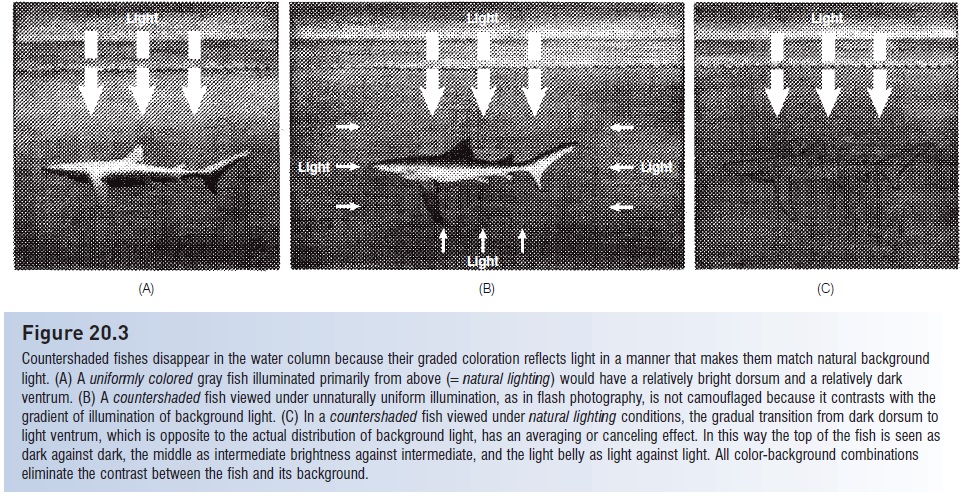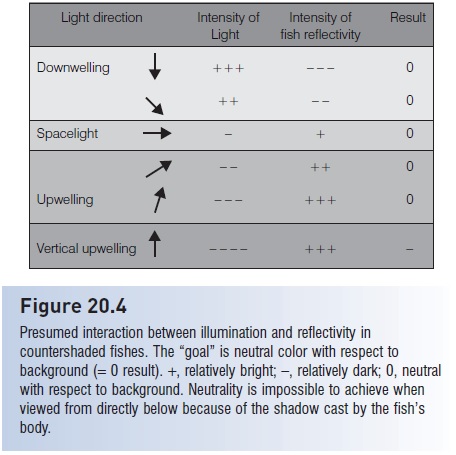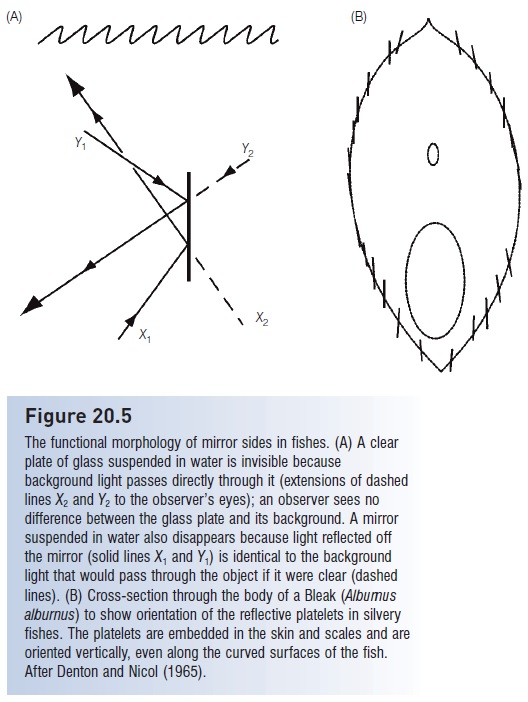Chapter: The Diversity of Fishes: Biology, Evolution, and Ecology: Fishes as prey
Avoiding detection: Invisible fishes - Fishes as prey
Invisible fishes
Protective resemblance and disruptive coloration are camoufl age tactics available to all organisms, regardless of habitat (Cott 1957; Edmunds 1974; Lythgoe 1979). Coloration that makes an animal literally disappear from view, rather than blend in with its background, exploits unique features of the distribution of light underwater. In air, all portions of the visible spectrum, from deep blue to deep red (c. 400–700 nm) are well represented. Hence objects of all possible colors can be found in most habitats. In addition, brightness varies substantially and irregularly as a function of sun and viewing angle. The brightest part of the sky may be the horizon during early morning and late afternoon. The ground, vegetation, or objects below an observer or viewed laterally may be as bright or brighter than objects overhead.
In water, however, light has a much more predictable distribution, particularly in open water situations where the bottom is not visible. Sunlight is refracted at the water’s surface, being bent downward even at relatively low sun angles. Hence the brightest light is consistently directly overhead or downwelling. Water molecules act as a powerful filter, both absorbing and scattering light; light attenuation is even stronger if dissolved or suspended particles that cause turbidity are present. Since all light underwater, with the minor exception of bioluminescence, originates as sunlight, objects viewed from above or horizontally will reflect light that has passed through the water filter.
Upwelling light consists of light photons that have passed down and then back up again through the water column and is the weakest component; upwelling light is typically only about 1% as strong as downwelling light. Horizontal space light is intermediate in strength, but again consists of light that has first passed vertically down and then horizontally through the water; space light is on average about 5% as strong as downwelling light.

Figure 20.3
Countershaded fishes disappear in the water column because their graded coloration reflects light in a manner that makes them match natural background light. (A) A uniformly colored gray fish illuminated primarily from above (=natural lighting) would have a relatively bright dorsum and a relatively dark ventrum. (B) A countershaded fish viewed under unnaturally uniform illumination, as in flash photography, is not camouflaged because it contrasts with the gradient of illumination of background light. (C) In a countershaded fish viewed under natural lighting conditions, the gradual transition from dark dorsum to light ventrum, which is opposite to the actual distribution of background light, has an averaging or canceling effect. In this way the top of the fish is seen as dark against dark, the middle as intermediate brightness against intermediate, and the light belly as light against light. All color-background combinations eliminate the contrast between the fish and its background
The attenuation of light with depth is also very symmetrical around the vertical, which means that a diver measuring light at 45° from the vertical will see the same quantity and quality of light whether the meter is pointed at a 45° angle north, south, or in any other direction. Similarly, light measured 90° off vertical (i.e., horizontally) will be identical ahead of and behind a viewer, etc. These two physical characteristics of light in water – uniform reduction with depth and uniform attenuation around the vertical – are primary influences on fish coloration, particularly in the context of camoufl age tactics that render the fish invisible.
Invisibility can be accomplished via three mechanisms: countershading, silvery sides, and transparency. Countershaded fishes grade from dark on top to light on the bottom (Fig. 20.3). The actual color or shade of the fish is less important than: (i) the strength of the light that the fish reflects, which differs at different angles from the horizontal; (ii) the background light against which the fish will be compared, and (iii) the viewing angle of the observer. Countershading is easiest to understand when viewing a fish from above. A fish with a dark dorsum absorbs bright downwelling light, thus presenting a dark target against the dark background of dim upwelling light. However, most fishes are viewed by their predators or prey from the side, and here the intricacies of countershading work best. When viewed from slightly above the horizontal, the darker dorsolateral surface of the fish absorbs relatively bright downwelling light, creating a dark target that is seen against the darkened background of slightly upwelling light. Similarly, if viewed from slightly below the horizontal, a light-colored ventrolateral surface reflects weak upwelling light, creating a relatively bright target seen against the lighter background of slightly downwelling light. A countershaded fish disappears

Figure 20.4
Presumed interaction between illumination and reflectivity in countershaded fishes. The “goal” is neutral color with respect to background (=0 result). +, relatively bright; –, relatively dark; 0, neutral with respect to background. Neutrality is impossible to achieve when viewed from directly below because of the shadow cast by the fish’s body
Countershading makes even more sense if one considers how a uniformly colored fish, or one that has reverse countershading, might appear. A uniformly light-colored fish would blend into the brighter background when viewed from positions below the horizontal because it would reflect available upwelling light. However, it would reflect even more downwelling light when viewed from above and hence become a bright target viewed against the dark background of weak upwelling light. Conversely, a uniformly dark fish would absorb downwelling light and appear dark against the relatively dark upwelling background, but it would also absorb weak upwelling light and appear as a dark object against a bright background when viewed from below.
Reverse countershading would make the fish conspicuous at all angles of viewing, light against dark from above, and dark against light from below. Reverse countershading occurs in fishes, but these exceptions prove the rule that countershading is camoufl age. Many male fishes, such as sticklebacks, sunfishes, cichlids, and wrasses, take on bright dorsal or dark ventral colors during the breeding season, a time when conspicuousness helps them attract females and repel territorial intruders. The best proof-by-exception comes from the reversely countershaded mochokid upsidedown catfishes which feed on the undersides of leaves and even swim in open water in an upside-down orientation. A predacious Lake Malawi cichlid, Tyrannochromis macrostoma, exhibits reverse countershading and often attacks prey while upside down (Stauffer et al. 1999). Colorful reef fishes often superimpose their bright coloration over a countershaded body and vary the dominant color pattern depending on whether they are engaged in social interactions or avoiding predators.
It is not immediately obvious that silvery sides make a fish invisible. Mirror-sided fishes include some of the world’s most abundant and commercially important species, including herrings, anchovies, minnows, salmons, smelts, silversides, mackerels, and tunas. These and other mirror-sided fishes are predominantly open water, pelagic species that take advantage of the unique light conditions that prevail underwater. To understand how mirror sides work, one must imagine a piece of plate glass suspended in midwater (Fig. 20.5A). The glass is invisible because the background light passes right through it; an observer sees the water column background, not the glass. Because light attenuates uniformly with depth and is distributed symmetrically around the vertical, a flat mirror suspended underwater achieves the same effect as clear glass. The mirror reflects light of an intensity and color that is identical to the light that would be passing through a piece of glass suspended at the same locale, i.e., as if the mirror were not there. Light coming from a 45° angle above the horizontal and reflecting off the mirror and into the eyes of an observer located 45° below horizontal is identical to light that would pass through the mirror if it were clear glass. An observer comparing the light reflected off the fish with the background light sees no difference; the mirror, or fish, consequently disappears into the background.
Crucial to the function of mirror sides is that the fish maintains a vertical orientation at all times, since any deviation from verticality will reflect light that is either brighter or darker than the background (Johnsen & Sosik 2003). Anyone who has watched a school of bait fishes has witnessed periodic bright flashes as individuals deviate from vertical swimming. Mirror-sided fishes maximize verticality by being laterally compressed. The guanine and hypoxanthine crystals that actually reflect the light are embedded in the scales and skin and are stacked together in platelets. The reflecting crystals are separated by a space equal to about one-quarter of the wavelength of the light usually reflected, the theoretical optimum spacing for achieving reflectivity. Whereas the scales and skin conform to the curvature of the body, the reflecting platelets in the scales have a vertical orientation, even in regions where the body

Figure 20.5
The functional morphology of mirror sides in fishes. (A) A clear plate of glass suspended in water is invisible because background light passes directly through it (extensions of dashed lines X2 and Y2 to the observer’s eyes); an observer sees no difference between the glass plate and its background. A mirror suspended in water also disappears because light reflected off the mirror (solid lines X1 and Y1) is identical to the background light that would pass through the object if it were clear (dashed lines). (B) Cross-section through the body of a Bleak (Alburnus alburnus) to show orientation of the reflective platelets in silvery fishes. The platelets are embedded in the skin and scales and are oriented vertically, even along the curved surfaces of the fish. After Denton and Nicol (1965).
The third means of achieving invisibility is via relative transparency. This is a characteristic of fishes that live in very clear water immediately below the surface where the effects of sun angle are strongest and symmetrical distribution around the vertical is weakest. Halfbeaks and needlefishes fall into this category, along with some specialized freshwater forms such as the X-ray Tetra,
Pristella maxillaris, and Glass Bloodtail, Prionobrama filligera (Characidae);
African and Asian Glass Catfish (Schilbeidae, Siluridae);
bagrid catfishes in the genera Chandramara and Pelteobagrus;
a gymnotid knifefish, Eigenmannia;
and the Glass Fish,Chanda (Ambassidae).
Larvae and young juveniles of many fishes are pelagic and transparent, their pigmentation developing along with their later habitat preferences (see Larvae). The body musculature and to some extent the bones of such fishes are translucent and these fishes are consequently difficult to see. However, certain structures, most notably the eye, brain, and gonads, apparently cannot function in a transparent state; the gut also often contains prey that is opaque or quickly turns opaque when digested. These pigmented organs often have a silvery coating. The function of this silver film is poorly understood. It might reflect light as do the silver platelets in scales as described above, or the coating could shield delicate structures from harmful ultraviolet radiation that penetrates into clear, shallow water.
Related Topics